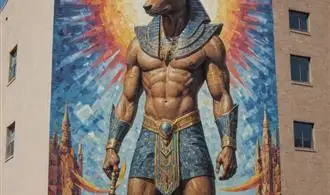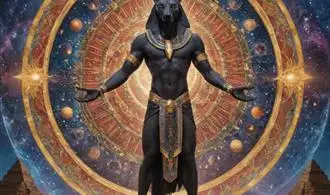
Who is Anubis the Egyptian God
Anubis, the ancient Egyptian god of the dead, holds a pivotal role in the intriguing realm of the afterlife. As the guardian of the passage from life to death, Anubis was revered for his role in ensuring a smooth transition for the deceased. With his distinctive jackal-headed form, Anubis was responsible for overseeing the embalming process, guiding the souls of the dead, and presiding over the weighing of the heart ceremony, a crucial step in the journey to the afterlife.
Anubis's origins can be traced back to the early dynastic period in Egypt, where he was associated with the embalming and mummification practices that were essential to the preservation of the deceased. His association with the jackal or wild dog stemmed from the fact that these animals were often seen scavenging near burial sites, making them a natural symbol for the guardian of the dead.
In the Egyptian pantheon, Anubis was considered a deity of great importance, responsible for protecting the dead and ensuring their successful passage to the afterlife. He was often depicted as a jackal-headed man, sometimes with a canine body, and was closely associated with the embalming process, the mummification of the dead, and the rituals surrounding the afterlife.
One of the most significant roles of Anubis was his involvement in the weighing of the heart ceremony, a critical step in the journey to the afterlife. During this ritual, the heart of the deceased was weighed against the feather of truth, symbolizing the purity and worthiness of the individual. Anubis was responsible for overseeing this process, ensuring that the soul of the deceased was found worthy and could continue on to the next stage of their journey.
Anubis's influence extended beyond the realm of the dead, as he was also associated with healing and protection. He was believed to have the power to ward off evil spirits and to guide the souls of the deceased through the dangers of the underworld. This made him a vital figure in the complex religious beliefs and rituals of ancient Egypt.
The The Unusual Insight Into the Symbolism of Anubis delves deeper into the symbolic meaning and significance of Anubis in the Egyptian pantheon, exploring the deeper layers of his role as the guardian of the dead and the afterlife.
The Role of Anubis in the Afterlife
Anubis, the jackal-headed god of ancient Egypt, held a crucial role in the intricate beliefs surrounding the afterlife. As the god of embalming and the protector of the dead, Anubis guided the deceased through the complex process of the afterlife, ensuring their safe passage to the realm of the eternal.
One of Anubis' primary responsibilities was the mummification of the dead. He was believed to oversee the entire mummification process, from the removal of the internal organs to the final wrapping of the body. This meticulous attention to detail was crucial, as the preservation of the physical form was believed to be essential for the soul's journey into the afterlife.
Furthermore, Anubis played a pivotal role in the weighing of the heart ceremony, a crucial step in the judgment of the deceased. During this ritual, the heart of the deceased was weighed against the feather of truth, represented by the goddess Ma'at. If the heart was found to be pure and true, the individual was deemed worthy to proceed to the afterlife. Anubis was responsible for conducting this solemn ceremony, ensuring the fairness and accuracy of the judgment.
Anubis' influence extended beyond the physical realm, as he was also believed to guide the souls of the dead through the perilous journey to the afterlife. He was often depicted accompanying the deceased through the underworld, protecting them from the dangers that lurked in the shadows. This belief was reinforced by the placement of Anubis statues and imagery in tombs and funerary sites, ensuring the god's constant presence and watchful eye over the departed.
In addition to his role as a guide and protector, Anubis was also believed to possess the power to resurrect the dead. This belief was particularly prevalent in the cult of Osiris, the god of the underworld, where Anubis was responsible for reviving the dead and ensuring their eternal existence in the afterlife.
The Rite of Mummification and Anubis
Anubis, the jackal-headed deity, played a vital role in the ancient Egyptian funerary rites, particularly the process of mummification. As the god of embalming and the afterlife, Anubis oversaw the critical and intricate steps involved in preparing the deceased for their journey to the afterlife.
The rite of mummification was a complex and meticulously performed ritual, designed to preserve the physical body and ensure the soul's safe passage to the afterworld. Anubis, the guardian of the dead, was the central figure in this process, guiding the embalmers and overseeing the transformation of the mortal remains into a sacred vessel for the Ka (the vital force or soul).
The mummification process typically involved the following steps, with Anubis playing a pivotal role in each:
- Removal of the internal organs: Anubis would guide the embalmers in the delicate extraction of the organs, which were then placed in canopic jars, each guarded by a different deity.
- Desiccation of the body: Anubis would oversee the application of natron, a salt-like substance, which would draw out the moisture from the body, effectively drying and preserving it.
- Wrapping the body: Anubis would ensure the proper wrapping of the body in linen bandages, with specific ritual spells and amulets placed between the layers to protect the deceased.
- Placing the body in the sarcophagus: Anubis would preside over the placement of the mummified body into the sarcophagus, the final resting place for the physical form.
Throughout the mummification process, Anubis played a crucial role in guiding the embalmers, ensuring the rituals were performed with the utmost care and respect. His presence was a testament to the profound importance of the afterlife in ancient Egyptian beliefs, and the reverence with which the deceased were treated.
Anubis and the Weighing of the Heart
In ancient Egyptian mythology, Anubis played a crucial role in the afterlife journey of the deceased. As the jackal-headed god of embalming and the protector of graves, Anubis was responsible for the vital ritual known as the "Weighing of the Heart." This ceremony determined the fate of the soul, ensuring the deceased's passage into the eternal realm of the afterlife.
The Weighing of the Heart ceremony was a complex and symbolic process that involved several key elements:
- The heart of the deceased was placed on one side of a scale, while the feather of Maat, the goddess of truth and justice, was placed on the other side.
- Anubis carefully observed the balance of the scale, ensuring that the heart's weight did not outweigh the feather, which represented the purity of the soul.
- If the heart was found to be true and righteous, it was allowed to pass into the afterlife, where the deceased would join the eternal cycle of existence. However, if the heart was found to be heavy with sin or deceit, it would be devoured by the monstrous creature Ammit, condemning the soul to eternal oblivion.
- Anubis not only presided over the Weighing of the Heart but also embalmed the body, ensuring its preservation for the journey into the afterlife. This process was crucial, as the Egyptians believed the physical form was a vital component of the soul's afterlife existence.
- The Weighing of the Heart ritual was often depicted in funerary art and texts, such as the famous Book of the Dead, where detailed instructions were provided for the deceased to navigate the challenges of the afterlife.
Symbolism and Significance of Anubis
Anubis, the ancient Egyptian god of the afterlife, held a profound and multifaceted symbolism within the rich tapestry of Egyptian mythology. As the god who presided over the mummification process and the journey of the dead into the afterlife, Anubis was imbued with a crucial role in the transition from life to the hereafter.
The distinctive jackal-headed figure of Anubis was not merely a visual representation but a embodiment of the complex concepts he encompassed. The jackal was chosen as Anubis' animal form due to the creature's association with cemeteries and the liminal spaces between the world of the living and the dead. Jackals were often observed roaming near burial sites, and this connection to the realm of the deceased solidified Anubis' position as the gatekeeper and guide to the afterlife.
Anubis' responsibilities extended beyond the physical act of mummification. He was believed to weigh the heart of the deceased against the feather of truth, a symbolic judgment that determined the individual's worthiness to proceed to the afterlife. This ritual, known as the "Weighing of the Heart," was a pivotal moment in the Egyptian conception of the afterlife, with Anubis playing a central role in this profound and transformative process.
The significance of Anubis extended beyond the realm of the dead; he was also associated with the protection of the living. As the patron of embalmers and the guardian of tombs, Anubis was invoked to safeguard the deceased and ensure the integrity of their final resting place. This dual role, as both a guide to the afterlife and a protector of the living, underscored the multifaceted nature of Anubis' symbolic importance in ancient Egyptian belief systems.
Furthermore, Anubis' association with the color black held deep symbolic meaning. Black was not only the color of the fertile Nile soil but also the color of the decomposing body, representing the cycle of life, death, and rebirth. This connection to the regenerative powers of nature reinforced Anubis' role as a deity who presided over the transition from mortal existence to the eternal realm of the afterlife.
















